Coney Island - Historic Roller Coasters
Revision June 2, 2004
The material is copyrighted © 1998 & 2004 by Jeffrey Stanton.
1.) Switchback Railway (1884 - 1885? )
- Type - Wooden Switchback Gravity Railroad
- Location - West 10th
- Builder & Designer - Thompson
- Height - 50 feet
- Length - 600 feet each way = 1200 feet
The world's first roller coaster opened on June 13, 1884. Passengers
seated sideways rode a train on undulating tracks over a wooden structure
600 feet
long. The train started at a height of 50 feet on one end and ran
downhill by gravity until its momentum died. Passengers left the train
and attendants pushed the cars over a switch to a higher level. The
passengers then returned to their seats and rode back to the original
starting point. Admission was 5 cents and Thompson grossed an average
of $600 / day.

|
Lamarcus Thompson's Switchback Railroad was the world's first roller coaster. The ride had two style cars in this photo. The car in the distance, which seated passengers sideways to enjoy the view, was the original design. - 1884
|
2.) Serpentine Railway (1885 - ? )
- Type - Wooden Gravity Railroad
- Location - It fronted the Iron Pier
- Builder & Designer - Alcoke
- Height -
- Length -
This gravity coaster was the first to tie the track end together
and return passengers to their starting point without them needing to
disembark while the car was placed on the return track. As usual the
train, with passengers seated sideways on a wooden bench, ran atop an
undulating wooden structure. The train was slow and took several
minutes to complete its circuit.
3.) Oval Coaster (1885 - ? )
- Type - Wooden Gravity Railroad
- Location -
- Builder & Designer - Phillip Hinckle
- Height
- Length -
Hinckle's coaster was a great advance in roller coaster design
since it was the first to have a hoist to pull cars to top of a
precipitous hill. The higher hill meant faster speeds and it was
the first to offer forward facing passengers thrills with mild
undulations instead of a tour of the countryside. It too had an
elliptical end turn so that passengers were returned to their starting
point.
4.) Elephant Scenic Railway (Shaw Channel Chute) (1886? - 1896)
- Type - Wooden - Out & Back
- Location - West Brighton wooden Elephant
- Builder & Designer - Shaw
- Height - Half way up elephant
- Length -
The coaster made a triple lap around the Elephant Hotel. Each 4 passenger
car, which was transported to the top by elevator,
had a brakeman, but the ride wasn't very exciting. It probably was
destroyed when the Elephant Hotel burned on September 27, 1896.
NOTE: The date the coaster
was built is in doubt. It appears in a 1886 map.
5.) Flip Flap Railway (1895 - 1902)
- Type - Wooden Looper
- Location - Sea Lion Park on Lagoon
- Builder & Designer - Lina Beecher
- Height - 25 foot diameter loop
- Length -
It was a very innovative ride as it was the first to flip passengers
upside down through a small 25 foot diameter loop. Cars that seated
two passengers descended from a high lift hill and sped through a
vertical loop. Centrifugal force held the car to the track at the top
of the loop. The ride had one flaw as its abrupt high G-forces in its
circular loop sometimes whiplashed (snapped?) passenger's necks.
6.) LA Thompson Scenic Railway (1897 - 1907)
- Type - Wooden Scenic Railway
- Location - Steeplechase ?? (correct ending year - it burned)
- Builder & Designer - Thompson
- Height -
- Length -
George Tilyou enticed LaMarcus Thompson with a guarantee of $40,000 to return to Coney Island and build a scenic railroad for him inside Steeplechase Park. Thompson's improved scenic railroad, which he perfected in Atlantic City, had tunnels, caves and a grotto which featured illuminated scenes. By the time it was built, electric power replaced steam power on its lift hill. It burned in the 1907 Steeplechase fire.
7.) Toboggan (1898? - 1906?)
- Type - Wooden
- Location - North side of Surf, but set back, near Luna entrance
- Builder & Designer -
- Height -
- Length -
This tiny toboggan coaster was adjacent to the Thompson Scenic Railway
on Surf Avenue along the right of way to Sea Lion Park. It appears in an 1898 map and certainly predates Luna Park and is clearly visible from photographs atop the Iron Tower. It was still there when Luna Park opened in 1903 and may have been incorporated as part of Luna Park.
8.) Channel Chute (1898? - 1900)
- Type - Wooden
- Location - South side Surf Avenue - just west of Iron Tower
- Builder & Designer -
- Height -
- Length -
It was a small coaster with an elliptical track layout, and inside, on the
seaward end, was a smaller oval that was probably used for loading and unloading.
The site was used later for the Pikes Peak Scenic Railroad.
9.) Spiral Railroad [possibly named Dante's Inferno Railway] (1900 - 1903)
- Type - Wooden scenic railroad
- Location - Surf Avenue
- Builder & Designer -
- Height -
- Length -
This early coaster was located west of the Great Musical Railroad, but set back by 30 to 40 yards from Surf Avenue. Its excitement, if any, was its long spiral drop on the seaward end. It was removed to build Dreamland.
NOTE: The possibility that it was named Dante's Inferno Railway
is a sign's appearance in an early photo that doesn't match a known coaster.
But another possibility for the name is for an unknown oval scenic railway
that appears on 1895 maps and is located along the beach just west of the
New Iron Pier and just east of the Coney Island Athletic Club. In a high
view postcard the structure appears to be covered by a roof, and probably
where Alcoke's Serpentine Railway (see #2) was located. The structure may
have been a remodel.
10.) Musical Scenic Express (Great Musical Railway) (1900 - 1905)
- Type - Wooden scenic railroad
- Location - Surf Avenue
- Builder & Designer - Jackman
- Height -
- Length -
This scenic railroad featured scenery in its tunnels depicting travel across the United States; at least that's what the sign says in front. One account of the time suggested that the ride's name was a puzzle, "unless the music was out being tuned." It did, however, have a humorous sign at the entrance of the first tunnel that read, "No Kissing Allowed in This Tunnel." But the ride's real thrill was the sight of a protruding beam that one suddenly spied after rounding a particular dangerous curve. It was barely discernible through the darkened space, but seemingly low enough to knock one's head clear off one's body. Of course passengers ducked instinctively as the beam passed over them by inches or perhaps by feet; it was most deceptive. But if one wanted to experience first hand what they would do if they faced certain death, the sensation could be experienced for only ten cents.
Some researchers claim that the ride featured an Old Mill and a second unknown ride beneath it, although its advertising sign doesn't indicate it. However, its replacement the Pike's Peak Railway, did have an Old Mill so that they might have retained it from the older ride.
11.) LA Thompson Scenic Railway (Sea Shell Scenic Railroad)(Marine Scenic Railway) (Glaciers Scenic Railway) (1898? - 1911)
- Type - Wood - Out & Back
- Location - Dreamland (west side)
- Builder & Designer - Thompson
- Height -
- Length -
This coaster predates Dreamland as it appears on a 1898 map. In 1904, when Dreamland opened, it was incorporated into the park along its west boundary. By 1906 it had been rebuilt and lengthened, and its new front featured railway loops in a great sea shell.
In April 1909 Dreamland announced the construction of a new Marine Scenic
Railway to be located over the water on a pier. A concept postcard was released
that showed it and sold on postcard stands. The mystery of where it was
located was solved, when a vertical view postcard taken from the Dreamland
Tower, showed the sign Marine Scenic Railway above the Sea Shell entrance
of the old Thompson Scenic Railway on the west promenade.
In 1910 the L. A. Thompson coaster was remodeled once again. The scenic railroad's scenery, based on a Trip to the North Pole, included scenes of ice floes, arctic animals and the ship "Roosevelt" caught in ice floes. The ride was demolished to make room for the Giant Racer.
12.) Loop The Loop (1901 - 1910)
- Type - Steel Looper
- Location - W. 10th Ave. & Surf Avenue
- Builder & Designer - Edward Prescott
- Height - 35 foot loop??
- Length -
This was the first truly safe looping roller coaster. It used an
elliptical shaped loop, thus eliminating the strain on passenger's
necks. Its cars had rubber wheels, carried four passengers and used
only centrifugal force to remain on the tracks. It didn't generate
much revenue since it could only carry four passengers every five
minutes. It was the first to charge admission just to watch. Apparently Prescott had planned to have multiple cars hooked together, but the Safety Code Committee examined it, and said to make it absolutely safe, only one car could be sent down at a time.
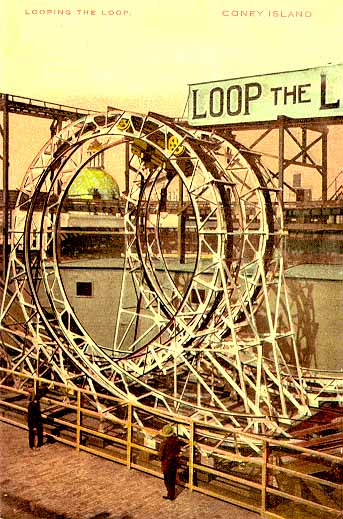
|
The Loop the Loop
|
13.) Deep Rift Coal Mine Scenic Railroad (1901? - 1905)
- Type - Wooden Scenic Railroad
- Location - Surf Avenue just east of Luna's entrance
- Builder & Designer - Thompson / Boyce
- Height -
- Length -
Passengers in coal mine cars toured this coal mine dark ride. Its
cars were pulled up a chain lift hill and slowly descended by gravity
as the cars passed illuminated life size figures of miners, work
animals and machinery that showed the operation of a mine. This ride
was removed when L.A. Thompson built a large ornate loading station for their scenic railway along Surf Avenue in 1906. (see #14)
14.) Oriental Scenic Railway (LA Thompson Scenic Railway)(Sea Beach Scenic Railway) (Electric Railway) (1901 maybe 1902 - 1954)
- Type - Wooden Scenic Railway
- Location - Surf Avenue - east of the Luna Park entrance
- Builder & Designer - Thompson
- Height -
- Length - 2100 feet
This scenic railroad featured a large ornate building erected in 1906 on Surf
Avenue that served as its loading station. The building's center piece was
an arch nearly 40 feet high, behind which was a 20 foot high waterfall cascading
over rocks. Its tracks after exiting the new building made a 90 degree turn
and headed north past the Sea Beach Palace behind it, then along side Luna
Park's eastern boundary. It was an slow ride originally with Oriental scenery
in its lighted tunnels. The ride had been built several years earlier and
operated from a small loading station set back about 50 feet from the street.
Its only serious accident occurred on June 21, 1923 when a trestle gave
way when the train was ten feet off the ground. Six people were hurt, one
seriously. Surprisingly the old fashion ride remained popular for decades
among families and romantic couples despite its proximity to nearby high
speed thrilling roller coasters. When the Mile Sky Chaser opened nearby
in 1924, business improved and it became so profitable that the owners turned
down an offer of $500,000 in 1926. Yet after the Depression hit, the bank
repossed it to salvage a $71,000 first mortgage. The bank managed to find
a buyer in the mid-30's. It was damaged in a fire in spring 1944 but was
rebuilt and repaired for that summer season. It out lasted Luna Park by
a decade.
NOTE: The year it opened is in doubt. An article in Billboard in 1953 said it was celebrating its 50th anniversary.
15.) Cannon Coaster (1902 - 1907?)
- Type - Wooden Out & Back
- Location - Henderson's Walk & Boardwalk
- Builder & Designer - Meyer
- Height - 40 feet??
- Length -
The ride was dubbed the Cannon Coaster when it was built because
the designers attempted to have the cars leap over a gap in the tracks.
At its apex it entered the breech of a large wooden cannon and as it
passed through its bore, it accelerated downward. As it shot out of the
cannon's mouth it was supposed to leap a gap in the tracks. They tested
the idea with sandbags instead of people, but it didn't work because
variations in the passenger's weight or uneven loads sometimes caused
crashes. They filled in the gap in this boring ride, but it still drew
crowds because stories still circulated of innumerable casualties during
its gap-in-the-track test runs. It certainly survived the 1907 Steeplechase fire that burned much of the Bowery.

|
The Cannon Coaster
|
16.) Star Double Toboggan Racer (1904 - 1906)
- Type - Figure 8
- Location - Bowery
- Builder & Designer - Ingersol
- Height -
- Length -
This coaster was billed as the only "handicap racing coaster in the world,"
so perhaps it was the first of its kind. Two two-passenger toboggan style
cars were simultaneously pulled up to the top of the lift hill, then raced
each other to the bottom along a two-track wide figure eight route.
17. L.A. Thompson Scenic Railway (Buzzard's Roost Scenic Railway)
(1904 - 1922)
- Type - Wooden - Out & Back
- Location - Luna Park at rear of park near Chutes
- Builder & Designer - Thompson
- Height -
- Length -
This scenic railway took its name Buzzard's Roost from the altitude obtained
on the ride, for it offered views of half of Coney Island from the top of
its lift hill. But I don't think it retained the name very long and was
generally known as just another L.A. Thompson Scenic Railway. Its domed
entrance pavilion to the left of Luna's Chutes ride had a loading station
200 feet long through which cars passed in plunging gradients.
18.) Coasting Thru Switzerland (1904 - 1911)
- Type - Wooden Scenic Railway
- Location - Dreamland (east promenade)
- Builder & Designer - Thomas Ryan
- Height -
- Length -
This indoor scenic railway was located on the west promenade and had a facade that depicted Switzerland's snowy alps. Visitors boarded red sleighs and entered the building through a long tunnel. Refrigerated air emitted from snowbanks added to the illusion, as passengers encountered roped climbers and passed thru a valley teeming with Swiss life and a vista of Mt. Blanc. The tracked cars made a slow descent.
19.) Ziz Mile Minute (Feltman's) (1904? or 1905 - 1908)
- Type - 3rd Rail Electric - Out & Back
- Location - W. 10th Street (west side on Feltman's property)
- Builder & Designer - Mangels
- Height - 35 feet
- Length -
The Ziz coaster, a scenic railway, ran through a grove of trees on the Feltman property. Its ocean turn was completely enclosed, but the ride wasn't very exciting or very popular.
20.) Dragon's Gorge (1905 - 1944)
- Type - Wooden scenic railroad
- Location - Luna Park
- Builder & Designer - Thompson / Miller
- Height -
- Length -
This scenic railroad featured scenes of the Arctic regions, the bottom
of the sea and other geographic regions of the world. One newspaper article years later claimed that magician Thurston designed its interior. The Dragon's Gorge had a beautiful
entrance grotto flanked by two griffins (dragons). It had the sharpest
turns and steepest drops of any scenic railroad and by remodeling it
periodically, it retained its popularity over the decades. The only serious accident was on August 21, 1925 when Mrs. Mary Meller's head struck the roof of the tunnel and suffered a concussion. The ride was the
site of the 1944 fire that destroyed half of Luna Park.
21.) Rocky Road to Dublin (1906 - 1923)
- Type - Electric 3rd Railer
- Location - Surf Avenue between W. 5th & 8th Street
- Builder & Designer - Miller / Mangels
- Height -
- Length -
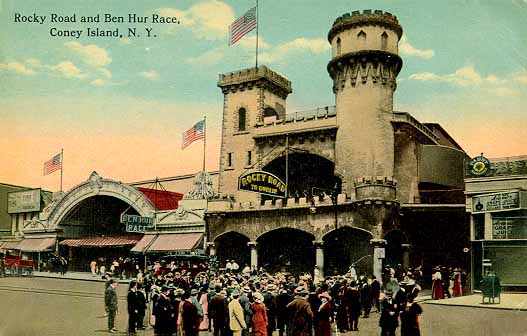
|
Rocky Road to Dublin and Ben Hur Race on Surf Avenue. - 1908
|
22.) Figure 8 (1906 - ???)
- Type - Wooden
- Location - Steeplechase on the beach on east side of pier
- Builder & Designer -
- Height -
- Length -
NOTE: This may be the same coaster as the Ocean Roller Coaster #30
if it survived the 1907 Steeplechase fire.
23.) Automobile Railroad (1906 - 1912??)
- Type -
- Location - Henderson Walk & the Bowery
- Builder & Designer - Neville
- Height -
- Length -
This unusual ride was a coaster in which passengers rode in imitation
automobiles along an undulating track. It was a gravity ride where the cars
were steered by the central guide rail. It was a successful attraction for
several years. Aka the Whirlfly.
24.) Pike's Peak Railway (1906 - 1911)
- Type - Wooden Scenic Railroad
- Location - Surf Avenue on east side of Dreamland
- Builder & Designer - Jackman / Thompson
- Height -
- Length -
The ride's structure was in the form of a mountain 138 feet high and 283
feet in circumference, representing Pike's Peak. The railroad ride was up
and around the mountain, through caverns and over precipitous crags, then
out and over railway gradients as it headed out towards the sea and back.
Beneath the ride along the street side was a second attraction called the
Whirlpool Rapids. The ride cost $100,000 to build. It met its demise in
1911 in the nearby Dreamland fire.
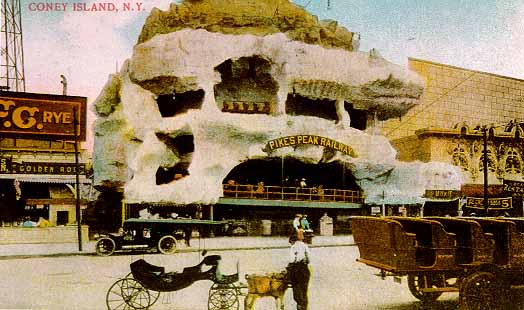
|
The Pikes Peak Railway on Surf Avenue.
|
25.) Mountain Torrent (1906 - ???)
- Type - Cars on a track that partially ran thru water
- Location - Luna Park - next to the Dragon's Gorge
- Builder & Designer - Fredrick Thompson
- Height - 80 feet??
- Length -
This ride was a combination roller coaster and Shoot-the-Chutes.
Passengers climbed mountain paths to the top of an 80 foot peak
where they boarded tracked cars which raced down a flume carrying
water at 35,000 gallons per hour. The ride ended with a splash in
a glacial lake at the bottom.
NOTE: It is believed that in 1910, the ride was converted into a
3rd rail scenic railroad. It is unknown if the name was changed. And it
is possible that this became the Grand Canyon Toboggan Railroad in the mid
1920's.
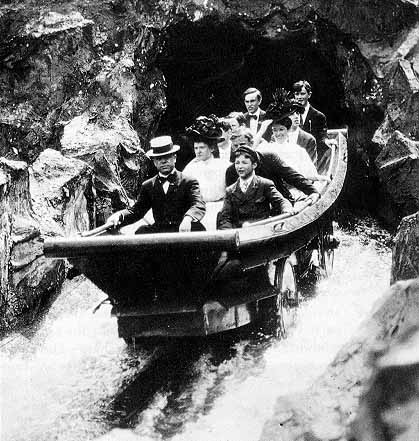
|
Luna's Mountain Torrent
|
26.) Rough Riders (1907 - 1915)
- Type - 3rd Rail Electric
- Location - Bowery & Jones Walk
- Builder & Designer - Mangels
- Height - 60 feet
- Length -
Seventeen people in two cars were pitched from the top of a sixty foot
peak on the Rough Riders switchback during the 1910 season. Incredibly,
only three of them died (not all of them hit the street). The reckless driver
got the train going to fast on the turn at 2 A.M. on June 22nd. Although
the motorman had just turned off the power after the ascent, the mechanism
jammed. The train, going too fast on the turn, caused the cars to overturn.
Third rail coasters were run by a motorman with a throttle so that he could
accelerate both uphill and on steep downgrades. Attendants wore Spanish-American
War uniforms and the trains carried passengers past murals depicting that
brief but heroic war before ascending the lift hill. Another similar accident
where the train derailed and jumped the track occurred on August 7, 1915.
The driver was killed instantly along with two passengers.
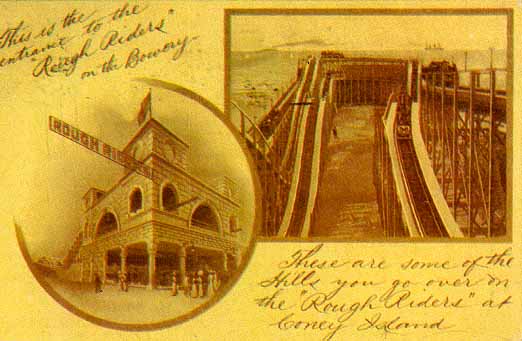
|
Rough Riders Scenic Railway was themed with scenes from the Spanish-American War and ride operators dressed in uniform.
|
27) Over the Great Divide (Trip over the Alps) (1907 - 1911)
- Type - Wooden Scenic Railroad - 3rd Rail Electric
- Location - Dreamland (east side)
- Builder & Designer - PTC / Albright
- Height - 50 feet
- Length - 2000 feet
Scenic railroad in which 20 passenger trains go up a 5-1/2% grade to a height
of 50 feet, then winds down by gravity, going through tunnels and over bridges.
The trains travel over Yellowstone Mountain and the Great Divide. A 70 foot
bridge connects the two peaks across a yawning canyon with a lake 40 feet
below. A volcano erupts at the highest point. The trains are each operated
by a motorman. The ride cost $100,000 to build.
There was a serious accident on the ride in July 1907 when a two
car train derailed as it was about to shoot down a steep incline into
a dark tunnel. A dozen people were hurt. The ride burned in the
Dreamland fire.
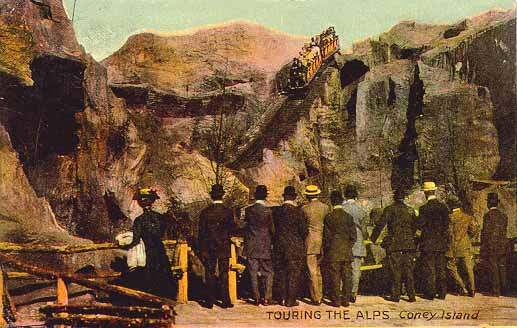
|
Touring the Alps in this postcard is actually Dreamland's Over the Great Divide. Not sure where they got the name, but probably a misprint on the card.
|
28.) Red Devil Rider (1907 - 1924)
- Type - Wooden
- Location - The Bowery
- Builder & Designer - Moran
- Height -
- Length -
NOTE: The Red Devil Rider may have lasted longer than 1923 , the year
the streets were widened. It is mentioned in Billboard as operating as
late as 1927.
29.) Drop-the-Dip (Trip to the Moon) (1907 - 1930's?)
- Type - Wooden
- Location - Jones Walk & the Bowery (West 15th Street);later Luna Park
- Builder & Designer - Mosley / Chris Feucht
- Height - 60 feet
- Length -
This coaster, which was built from a dentist's model and constructed by
Feucht, had oversize dips when it opened on June 6, 1907. Despite its small
coaster structure, 450 x 65 feet and a ride that lasted only 90 seconds,
at 25 cents a person, it could gross $20,000 a season. It was very popular
its first month but then it burned to the ground when Steeplechase was incinerated
on July 28th. It had four passenger toboggan like cars and some of the steepest
drops of a coaster to that date.
Since Feucht felt that his first design was too conservative, he added
scarier features for his reconstructed coaster. The result was long lines of paying customers and
many requesting re-rides. It was considered the first modern high-speed
roller coaster and the designer invented the lap bar to keep
passengers from flying out of his cars. It is best remembered for its
savage hills and turns.
It may be hard to believe, but Feucht in 1915
within a 24 hour period actually moved the ride across the street to
avoid a rent raise. The coaster was moved again in January 1924 to Luna Park by Jarvis and
100 workers to make way for the widening of the Bowery to improve fire
fighting access. It operated into the early 30's at a location east of the Luna's 125 foot tall Tower and south of its Ballroom. Its loading station may have been themed since the park called it the "Trip to the Moon."

|
Drop the Dips
|
30.) Ocean Roller Coaster (1908 ??-1923??))
- Type - Wooden
- Location - Steeplechase along the beach
- Builder & Designer -
- Height -
- Length -
This small coaster, a figure eight design, is often mentioned on the combo ticket as early as
1912. However, it may have been built earlier and may be a figure eight
coaster that appears on 1906 maps if it escaped the 1907 fire. It was
certainly removed when the Boardwalk was built, but probably moved prior to that to the corner of Surf Avenue and W. 16th. When the courts ruled in 1916 that the public had access to the fenced off sections of the beach, a coaster structure appeared in the corner of one photo, and on a publicity map dated 1917.
NOTE: May be the same as #22.
31.) Ben Hur Chariot Race (1908 - 1927?)
- Type - Wooden 2 Track Racer - 3rd Rail
- Location - Surf Avenue
- Builder & Designer - Mangels
- Height -
- Length -
This was a very small compact two track racing coaster. It may have been damaged in a 1910 fire and it was thought to be demolished after the 1923 season when Surf Avenue was widened for better fire fighting access. But it appears in a 1927 aerial photo. The question is whether it operated after 1923 since a photos shows a "For Lease" sign. It was a very small compact coaster and could have been easily moved 30 feet back from the newly widened street. Another ride, a Tumblebug, occupied the site in 1928.
32.) The Great Whirlwind Ride (1909 - 1911)
- Type - Wooden - Out & Back
- Location - Surf Avenue opposite Culver Depot
- Builder & Designer - Jackman
- Height -
- Length -
This coaster burned during the Dreamland fire.
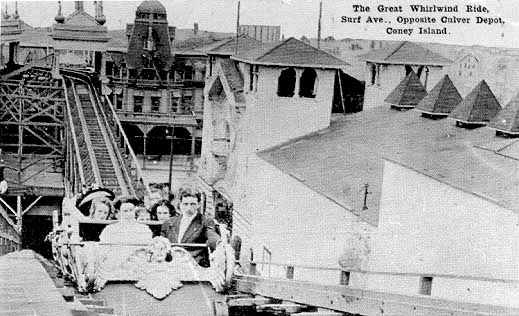
|
The Great Whirlwind Ride
|
33.) Jackman's Thriller (1911 - 1923)
- Type -
- Location - Bowery south of Thompson's Walk
- Builder & Designer - Jackman
- Height -
- Length -
On July 2nd, 1923, a night watchman walking the tracks rather than the catwalk, who was distracted by approaching fire engines to a nearby blaze, was hit by a train. He plunged to his death on the street below. The coaster was removed in 1923 when Coney's many narrow streets
were cleared for better fire fighting access.
34.) Giant Racer (1911 - 1926)
- Type - Steel racing coaster
- Location - Surf Avenue & West End Street
- Builder & Designer - Jarvis
- Height -
- Length -
The 900 foot long steel two-track racing coaster was built at a cost
of $180,000. Its steel super structure enabled it to survive the
nearby Dreamland fire. The coaster had a terrible accident in 1911
when a Giant Racer train left the tracks on a curve fifty feet above
Surf Avenue. Two woman were killed.
In 1916, to increase business, the
coaster was placed on rollers and its entrance moved 70 feet closer to
Surf Avenue. Gross revenue increased $3,700 the year after the move. The move was also likely a required one since it occupied a section of beach that the courts that year ruled that the public had a right to free access of the beach.
There was another bad accident on February 28, 1925 prior to the season
opening. Men testing the ride were on it as the train of cars were pulled
up the lift hill. A coupling pin broke as the train neared the top and the
last two cars slid down hill and crashed into beams at the bottom. Three
men were severely hurt. The ride was removed after the 1926 season to build
the Cyclone.
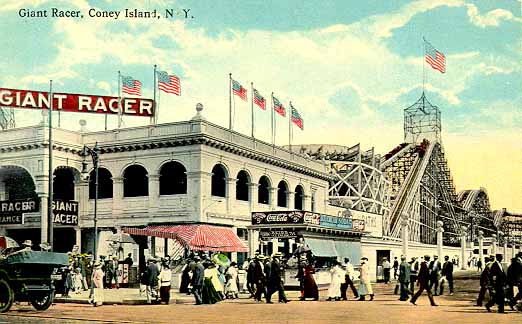
|
The Giant Racer
|
35.) Automobile Railroad (1912 - 1915)
- Type -
- Location - Culver Depot on Surf Avenue
- Builder & Designer -
- Height -
- Length -
This was a small coaster with automobiles running along its undulating
track.
36.) Scenic Spiral Wheel (The Top) (1917 - 1920)
- Type - Tilting Spiral Scenic Railroad - Steel
- Location - Luna Park
- Builder & Designer -
- Height -
- Length -
Imagine a spiral roller coaster built into a child's gigantic top
with one edge resting on the ground. As the coaster car made its way
down, its weight shifted the top's resting point so that the whole
contraption tilted as you spiraled around and round towards the
ground.
37.) Big Dipper / Wildcat / Comet (1921 - 1945)
- Type - Wooden
- Location - Surf Ave just east of the Giant Racer
- Builder & Designer - Baker
- Height - 52 feet drop
- Length -
This coaster was renamed the Wildcat in 1934. Apparently Tilyou, its new
owner didn't like that name either because they renamed it the Comet.
It stood on Surf Avenue on the site of Thomson's 1884 Switchback
Railroad just east of the Giant Racer and later the Cyclone. The location
is now the site of the New York Aquarium's parking lot. There was one known
death on the ride, when on August 12, 1941 a young man fell from the coaster.
38.) Mile Sky Chaser (1923 - 1944)
- Type - Wooden - Out & Back
- Location - Luna Park
- Builder & Designer - Jarvis
- Height - 80 ft??
- Length - 3850 (estimate from map)
This enormous coaster ran along Luna Park's perimeter, mainly on the west
and back sides. The loading station was near Surf Avenue at its entrance.
It was originally built by Jarvis at Brighton Beach in 1910 and known as
the Chase Thru the Clouds. When the park burned in 1919, the coaster was
abandoned until Jarvis, as Luna's new manager, needed a more thrilling coaster
and decided to move it. Newspapers reported that it cost $140,000 to build,
but that might have been the original cost added to the rebuilding cost;
but it does seem excessive. They also claimed that it had drops pf 95 feet,
75 feet and 65 feet; somewhat of an exaggeration. It burned in the final
Luna Park fire.
39.) Thunderbolt (1925 - 1982)
- Type - Wooden
- Location - Bowery & Stillwell Avenue
- Builder & Designer - Miller
- Height - 86 feet
- Length -
This Miller designed wooden coaster has a house beneath it. The building
was part of the two-story Kensington Hotel (top story removed). Beams of
the coaster actually are part of the house's structure. The house belonged
to owner George Moran and later his son Fred. The Woody Allen character in
the movie Annie Hall lived there and there would be periodic shaking of
the furniture and china. The coaster still stands but isn't operating.
The Thunderbolt had two serious accidents during the first two years it was opened. A women was killed on August 21, 1925 when she was thrown forward and her head hit the metal handle bar in front of her. A more serious accident occurred on July 26, 1926 when a three car train stalled part way up a hill. As it rolled back down to the bottom, it was struck by the following train. Twelve people were injured, one seriously.
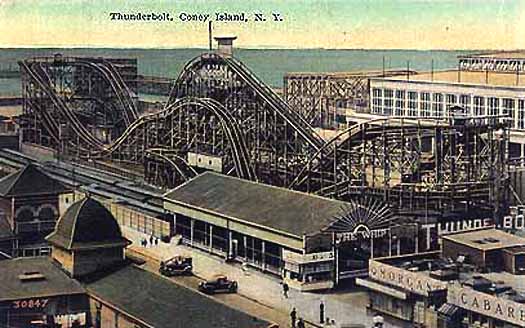
|
Thunderbolt roller coaster
|
40. The Limit (1925 - 1934)
- Type - Wooden
- Location - Steeplechase near the Boardwalk
- Builder & Designer - Miller
- Height - 55 feet
- Length - 1300 feet approx
This out and back coaster was located near the Boardwalk behind Noah's Ark. It stretched from W. 16th to W 19th with the first lift hill near W. 16th. It was removed in January 1934 to make room for the Flying Turns ride. Its lift hill and first drop were incorporated into the new ride.
41.) Zip / Steeplechase Coaster (1925 - 1964)
- Type - Wooden
- Location - Steeplechase Park
- Builder & Designer - McKee / Miller
- Height - 35-40 ft
- Length - 2200 ft
The Zip was a small coaster that ran along W. 19th Street to Surf
Avenue.
42.) Kiddie Coaster (1926 - ???)
- Type -
- Location - possibly at Feltman's
- Builder & Designer - Thompson
- Height -
- Length -
43.) Tornado / Bobs (1926 - 1977)
- Type - Wooden Twister
- Location - Henderson Walk & The Bowery
- Builder & Designer - Thompson & Darling / Prior & Church
- Height - 71 feet (55 feet on first spiral drop)
- Length - 2970 feet
The coaster was built on a very difficult narrow lot that was only
70 feet at its widest and tapered to only 50 feet. Fortunately they were
able to design in a five foot overhang along Henderson Walk. The ride
cost $250,000 when it opened on Memorial Day 1926. Luckily it earned
$300 / hour, at least until the Depression. It was a spectacular
thriller with exciting drops, tight turns and crossovers that only
Prior and Church's articulated cars could negotiate.
Of course, there were occasional deaths, but the one that is most
remembered was in 1937 when a high school boy was pitched out of a
twenty passenger car at the beginning of the season. Hundreds heard
the scream and saw the boy's fall to the tracks below. He was lying
only ten feet above the ground, but the following train ran him over
before he could be rescued. The district attorney decided to investigate
coaster safety, but soon the furor died down and operations at Coney
resumed as normal.

|
The Tornado/Bobs
|
44.) Cyclone (1927 - present)
- Type - Wooden Twister
- Location - Surf Avenue & West End Street
- Builder & Designer - Vernon Keenan / Baker
- Height - 85 feet
- Length - 2640 feet (ride length 1 min 50 sec)
This roller coaster masterpiece cost Jack and Irving Rosenthal
$100,000 to build, but it returned their investment within weeks
after it debuted on June 26, 1927. It was a fast twister coaster
set in a figure 8 design. and a true trilling ride.
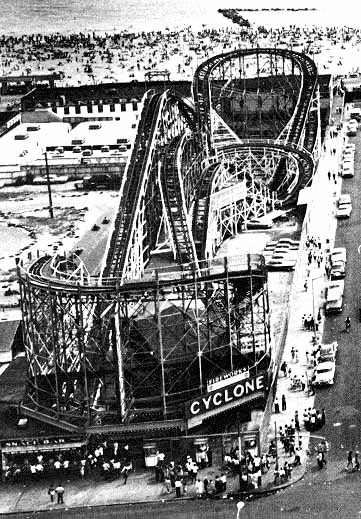
|
The Cyclone
|
45.) Flying Turns (1934 - 1939)
- Type - Bobsled trains on a wooden track
- Location - Steeplechase
- Builder & Designer - Bartlett / Miller
- Height -
- Length -
This Flying Turns ride differed from later versions of the bobsled ride
in that it gained speed from a separate high lift hill and drop (the remains
of the old Limit roller coaster). The train of five linked cars on wheels
would then be thrust into a series of tightly banked figure eight turns.
The ride burned in a fire in 1939 that originated at the nearby boardwalk.
46.) Bobsled (1941 - 1974)
- Type - Bobsled trains on a wooden track
- Location - Stillwell Ave. & W. 15th
- Builder & Designer - Bartlett
- Height -
- Length -
This "Flying Turns" ride was originally built for the 1939 New York World's
Fair. After the fair closed the ride was moved to Coney Island. The wheeled
trains rode down flume wooden tracks and like a real bobsled banked steeply
as they rode high on the track's outer walls. The trains were launched from
a high lift hill, where they gained speed of at least 50 MPH as they traveled
upward into the tight helix turns of the figure 8 course.
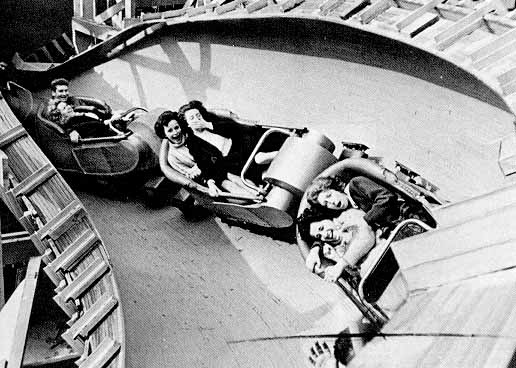
|
The Bobsled toboggan ride located on the Bowery.
|
47.) Little Dipper (1949 - ???)
- Type - Wooden
- Location -
- Builder & Designer - Alan Herschel
- Height -
- Length -
This was a kiddie coaster built by Alan Herschel Company.
48.) Jumbo Jet (1973 - 2003)
- Type - Steel
- Location - Bowery & Stillwell Ave.
- Builder & Designer - Anton Schwartzkoff
- Height - 56 feet
- Length - 2854 feet
Important Note:While it is felt that this list is complete, there
are two names un attributed to any of these 50 roller coasters. In 1916
an article about structures encroaching on the public beach mentions the
Sea Beach Coaster; obviously it must have been along the Bowery.
And in 1914 an article mentions a Panama Scenic Railroad. Some researchers
feel that a narrow coaster-like structure, with a sign saying "Have You
Ridden the Goat?," located along the north side of the Bowery near
W. 16th is a coaster. I disagree as it is much too small and lacks a lift
hill. Certainly the structure is ramped with no dips, but carts might have
rolled down it, or perhaps passengers were pulled in carts by goats??
THE FOLLOWING TWO COASTERS WERE IN BRIGHTON BEACH
49.) Giant Roller Coaster (1907 - 1909)
- Type -
- Location - Brighton Beach Park across from Brighton Beach Hotel
- Builder & Designer - LA Thompson
- Height -
- Length - 6150 feet
At the time, it was the longest coaster ever built. Trains seated 30 passengers.
NOTE: A Billboard article dated 7/12/41 says a Thompson coaster at 1904 St. Louis Fair was moved to Brighton Beach.
50.) The Chase Through the Clouds (1910 - 1919)
- Type - Steel Racing Coaster
- Location - Across from the Brighton Beach Hotel
- Builder & Designer - Jarvis
- Height -
- Length -
This racing coaster was built by the Giant Safety Racing Company. A 1919 fire destroyed the amusement zone but spared the roller coaster. After being abandoned for several years, it was moved to Luna Park in 1923 to become the Mile Sky Chaser.
NOTE:Since there isn't room for two coasters, I based my two closing dates on #50, replacing #49 and the closing of the park after the fire.
|














